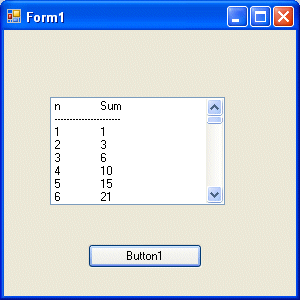In Visual Basic 2010 programming, a sequence of instructions that is repeated until a certain condition is met is called looping. For example, we can write VB code that adds a series of numbers until the sum exceeds a certain value or a VB program that asks the user to enter data repeatedly until he or she enters the word 'Finish'. In Visual Basic 2010, we have three types of Loops, they are the For.....Next loop, the Do loop. and the While.....End while loop
The syntax for looping using the For...Next loop is:
For counter=startNumber to endNumber One or more statements Next
To exit a For.....Next Loop, you can place the Exit For statement within the loop; and it is typically used together with the If....Then.....statement. For its application, you can refer to example 11.1 d.
Dim counter as Integer For counter=1 to 10 ListBox1.Items.Add (counter) Next
* The program will enter number 1 to 10 into the list box.
Dim counter , sum As Integer For counter=1 to 100 step 10 sum+=counter ListBox1.Items.Add (sum) Next
*The program will calculate the sum of the numbers as follows:sum=0+10+20+30+40+......
Dim counter, sum As Integer sum = 1000 For counter = 100 To 5 Step -5 sum - = counter ListBox1.Items.Add(sum) Next
*Notice that increment can be negative.The program will compute the subtraction as follow: 1000-100-95-90-..........
Dim n as Integer For n=1 to 10 If n>6 then Exit For End If Else ListBox1.Items.Add ( n) Next End If Next
The process will stop when n is greater than 6.
The Do Loop structures are
Do While condition Block of VB 2010 statements Loopb)
Do Block of VB2010 statements Loop While condition
Do Until condition Block of VB2010 statements Loopd)
Do Block of VB 2010 statements Loop Until condition
Sometimes we need to exit a loop prematurely because a condition is fulfilled. The keyword to use is known as Exit Do.Let's examine the following examples
Do while counter <=1000 TextBox1.Text=counter counter +=1Loop
* The above example will keep on adding until counter >1000.
The above example can be rewritten as
Do TextBox1.Text=counter counter+=1 Loop until counter>1000
Private Sub Button1_Click(ByVal sender As System.Object, ByVal e As System.EventArgs) Handles Button1.Click
Dim sum, n As IntegerListBox1.Items.Add("n" & vbTab & "Sum")
ListBox1.Items.Add("----------------------")
Do
n += 1
sum += n
ListBox1.Items.Add(n & vbTab & sum)
If n = 100 Then
Exit Do
End If
Loop
End Sub
In the above example, we find the arithmetic summation of 1+2+3+4+......+100. In the design stage, you need to insert a ListBox into the form for displaying the output.The program uses the Add method to populate the ListBox. The statement
ListBox1.Items.Add("n" & vbTab & "sum")
will display the headings in the ListBox, where it uses the vbTab function to create a space between the heading n and sum.
The statement
ListBox1.Items.Add(n & vbTab & sum)
will list the number n and the values of the arithmetic summation. The output is displayed below:

The structure of a While....End While is very similar to the Do Loop. The syntax is as follows:
While condition Statements End While
The above loop means that while the condition is not met, the loop will go on.The loop will end when the condition is met.
Dim sum, n As Integer
Private Sub Button1_Click(ByVal sender As System.Object, ByVal e As System.EventArgs) Handles Button1.Click
Dim sum, n As Integer
While n <> 100
n += 1
sum = sum + n
ListBox1.Items.Add(n & vbTab & sum)
End While
End Sub
Copyright©2008 Dr.Liew Voon Kiong. All rights reserved |Contact|Privacy Policy